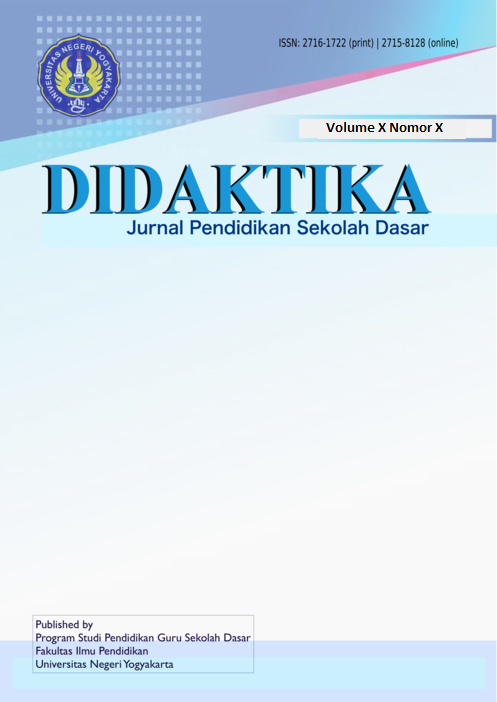Pengembangan Desain Pembelajaran STEM dalam Kurikulum 2013 di Sekolah Dasar: Suatu Analisis dan Eksplorasi
DOI:
https://doi.org/10.21831/didaktika.v3i2.33303Abstract
The design and learning of STEM in elementary schools are still not widely used in learning in elementary schools. STEM learning is relevant to the 2013 curriculum, like the current. Thematic learning. Thus, it is necessary to develop a STEM learning design, using development based research, namely EDR (Educational Design Research). The goal is to produce STEM learning projects that have been designed in the form of lesson plans for fifth-grade elementary school students. The method used in this research is development based research, namely EDR (Educational Design Research) with data collection techniques including interviews, discussions, observations, document analysis or documentation studies, and questionnaires. The subjects in this study were fifth-grade elementary school students. This article presents the analysis and exploration results, which is the first stage in this research, covering initial orientation, literature study, field-based investigations, field visits, professional meetings, and networking. This study aims to confirm that STEM learning in the 2013 curriculum is very appropriate for supporting the fulfillment of 21st-century skills for elementary students. The products produced from the first stage are problem definition, long term goals, partial design requirements, and initial designs.
Keywords: STEM Learning, 2013 Curriculum, 21st Century Skills
====================================================================================================
Penelitian ini bertujuan untuk mengembangkan desain pembelajaran STEM di Sekolah Dasar dengan menggunakan penelitian berbasis pengembangan yaitu EDR (Educational Design Research). Penelitian ini menghasilkan proyek pembelajaran STEM yang telah dirancang yaitu RPP (Rencana Pelaksanaan Pembelajaran) untuk siswa kelas V Sekolah Dasar. Artikel ini menyajikan hasil analisis dan eksplorasi yang merupakan tahap pertama dalam penelitian ini, meliputi orientasi awal, studi literatur, investigasi berbasis lapangan, kunjungan lapangan, pertemuan profesional, dan jejaring dilakukan melalui berbagai metode: wawancara, diskusi, observasi, dan analisis dokumen dengan strategi meliputi: strategi sintesis kebijakan, bidang potret, kumpulan persepsi, dan analisis SWOT. Hasil dari penelitian ini yaitu mengkonfirmasi bahwa pemeblajaran STEM dalam kurikulum 2013 sangat tepat diterapkan dalam mendukung terpenuhinya keterampilan abad 21 bagi siswa Sekolah Dasar. Produk yang dihasilkan dari tahap pertama adalah definisi masalah, tujuan jangka panjang, persyaratan desain parsial dan desain awal.
Kata kunci: Pembelajaran STEM, Kurikulum 2013, Keterampilan Abad 21
References
Becker, K., & Park, K. (2011). Effects of integrative approaches among science, technology, engineering, and mathematics (STEM) subjects on students' learning : A preliminary meta-analysis. Journal of STEM Education. https://doi.org/10.1037/a0019454
Blackley, S., & Howell, J. (2015a). A STEM narrative: 15 years in the making. Australian Journal of Teacher Education, 40(7), 102–112. https://doi.org/10.14221/ajte.2015v40n7.8
Blackley, S., & Howell, J. (2015b). A STEM narrative: 15 Years in the making. Australian Journal of Teacher Education, 40(7), 102–112. https://doi.org/10.14221/ajte.2015v40n7.8
Cunningham, C M, & Hester, K. (2007). Engineering is Elementary : An Engineering and Technology Curriculum for Children. Engineering Education, 1–17. Retrieved from http://www.mos.org/eie/research_assessment.php
Cunningham, Christine M. (2018). Engineering in Elementary STEM Education Curriculum Design, Instruction, Learning, and Assessment (New York). Teachers College Press.
Lidinillah, D. A. M. (2017). Pengembangan Model Pembelajaran STEM (Science, Technology, Engineering, and Mathematics) Untuk Mendukung Penerapan Kurikulum 2013 Di Sekolah Dasar. Universitas Pendidikan Indonesia Kampus Tasikamalaya.
Lidinillah, D. A. M., et al. (2019). Integration of STEM learning into the elementary curriculum in Indonesia: An analysis and exploration. Journal of Physics: Conference Series, 1318(1). https://doi.org/10.1088/1742-6596/1318/1/012053
McKenney, S., & Reeves, T. C. (2014). Educational design research. In Handbook of Research on Educational Communications and Technology: Fourth Edition. https://doi.org/10.1007/978-1-4614-3185-5_11
Nugraha, R. S., Sumardi, & Hamdu, G. (2017). Desain Pembelajaran Tematik Berbasis Outdoor Learning Di SD. Indonesian Journal of Primary Education Desain Pembelajaran Tematik, 1(1), 34–40.
Nurlenasari, et al. (2019). Assessing 21 st century skills of fourth-grade student in STEM learning. Journal of Physics. https://doi.org/10.1088/1742-6596/1318/1/012058
OECD. (2016). Result from PISA 2016. 1–8. Diakses dari: https://www/oecd.org/pisa/PISA-2015-Indonesia.pdf.
OECD. (2019). Result From PISA 2018. Diakses dari: https://www.oecd.org/pisa/Combined_Executive_Summaries_PISA_2018.pdf.
Plomp, Tjeerd. & Nieveen, N. (2013). Educational design research. In Netherlands Institute for Curriculum Development (SLO). https://doi.org/10.1007/978-1-4614-3185-5_11
Sanders, M. (2009). STEM, STEM Education, STEMmania. The Technology Teacher, 20–27. Retrieved from https://vtechworks.lib.vt.edu/bitstream/handle/10919/51616/STEMmania.pdf?sequence=1&isAllowed=y
Sugiyono. (2012). Metode Penelitian Kuantitatif, Kualitatif dan R&D. Bandung: Alfabeta.
Sugiyono, P. D. (2014). Metode Penelitian Kuantitatif, Kualitatif dan R&D. Bandung: Alfabeta.
Suharsimi, A. (2013). Prosedur Penelitian : Suatu Pendekatan Praktik (Edisi Revisi). In Jakarta: Rineka Cipta. https://doi.org/10.1017/CBO9781107415324.004
Sulistia, S., et al. (2019). Promoting engineering for fourth-grade students through STEM learning. Journal of Physics: Conference Series, 1318(1). https://doi.org/10.1088/1742-6596/1318/1/012054
Syukri, M., & Dkk. (2013). Pendidikan STEM dalam Entrepreneurial Science Thinking "ESciT": Satu Perkongsian Pengalaman dari UKM untuk Aceh. Aceh Development International Conference, 105–112.
Downloads
Published
How to Cite
Issue
Section
Citation Check
License
- Authors retain copyright and grant the journal right of first publication with the work simultaneously licensed under a Creative Commons Attribution License that allows others to share the work with an acknowledgement of the work's authorship and initial publication in this journal.
- Authors are able to enter into separate, additional contractual arrangements for the non-exclusive distribution of the journal's published version of the work (e.g., post it to an institutional repository or publish it in a book), with an acknowledgement of its initial publication in this journal.
- Authors are permitted and encouraged to post their work online (e.g., in institutional repositories or on their website) prior to and during the submission process, as it can lead to productive exchanges, as well as earlier and greater citation of published work.






